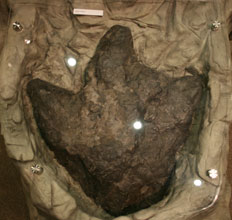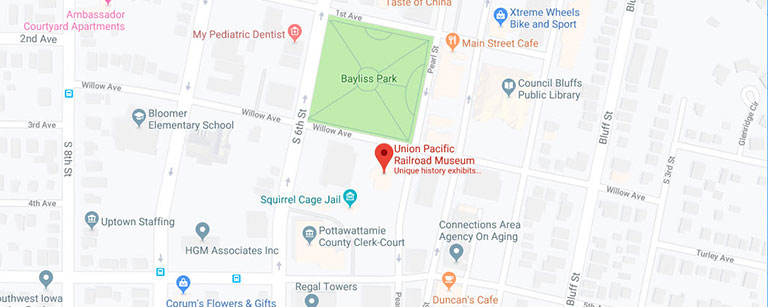Footprint in Time

This object is the impression of a dinosaur's footprint left at sometime in the late Cretaceous period some 89 to 65 million years ago. This three-toed print was most likely left by a large Therapod (carnivorous) dinosaur. Its size, well over 2 feet in length, suggests that it may have even been left by a Tyrannosaurus Rex!
The dinosaur that left this print made impressions in the layer of peat moss while walking near what is now the Rock Springs, Wyo. area. That impression eventually filled with water, sand and other sediments. The peat moss eventually became coal and the mold of that long ago carnivore's footprint became part of the coal seam. It most likely would have been discovered on the ceiling of the coal mine, or at the bottom of the coal layer. Imagine looking up to see this big three-toed footprint hanging above you!
So why is this object part of the Union Pacific Historical Collection? This story goes back to the subject of resources during the construction of the original transcontinental railroad, 1862-1869. It was often a struggle for Union Pacific to find enough natural resources to build the railroad through the Great Plains. Wood was scarce; scarce for railroad ties, scarce for building, and scarce for fuel for the locomotives. The lack of available fuel was of particular interest to the railroad with each locomotive needing an estimated 800 cords of wood per year to operate! So Union Pacific began to look around for other possible sources of fuel. Coal had been discovered in Wyoming as early as the 1850s and in 1866 General Dodge (Chief Engineer for Union Pacific, 1866-1869) employed a geologist to do more research. Coal was an attractive fuel option for the railroad because it had a much better heating ratio per pound than did wood, producing more steam for less volume of fuel.
By 1868, the rich coal fields discovered in Wyoming were booming; providing the much needed coal for the railroad to finish the transcontinental railroad. Originally the mines at Rock Springs and then Hanna, Wyo. were operated by contract with Thomas Wardell and C.O. Godfrey, of Hannibal, Missouri. Then, from 1874 to 1890, the mines were administered by Union Pacific under a special coal department created for this task. By 1890, the production of the mines became too much for a small department to administer and the Union Pacific Coal Company was created to handle all of Union Pacific's coal interests in the region. It was a President of the Union Pacific Coal Company, E. McAuliff, who presented the footprint to Union Pacific in the 1920s.
Many thanks to Dr. George Engelmann, professor at the University of Nebraska at Omaha, geosciences faculty, who was kind enough to examine this object for the Museum.
White, John H. A History of the American Locomotive: Its Development, 1830-1880. New York: Dover Publications, 1979. Print.
McAuliff, E. A. A History of the Union Pacific Coal Company. Omaha: Union Pacific, 1940. Print

